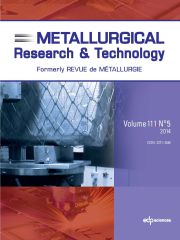Article contents
A new scrap grade for the steel industry: steel wire recyclingfrom the treatment of end-of-life tires
Published online by Cambridge University Press: 15 April 2011
Abstract
This article presents the work carried out to define quality criteria of a new scrapsource for the steel industry: steel wires generated by grinding end-of-life tires. Thedefinition of this promising new secondary raw material source is perfectly in agreementwith the European Directives 75/442/CEE and 2000/53/EC, dealing with waste and recyclingof end-of-life vehicles, thus answering the environmental needs of our society.
Grindingtires generates an interesting secondary raw material (rubber granulates) but also twowastes, steel wires and textile fibers. We estimate that steel wires represent in Europe180 kt of steel every year which is not, or badly, valorized. This study showed that therecycling of these steel wires in steel mills was possible and viable, one necessarycondition being the determination of the non-metallic content remaining on the wires andkeeping it lower than 4%.
Keywords
- Type
- Research Article
- Information
- Copyright
- © EDP Sciences
- 1
- Cited by


